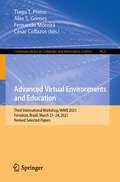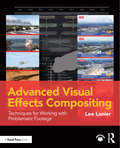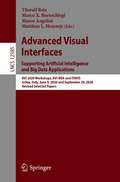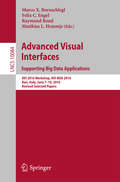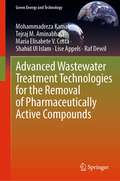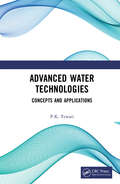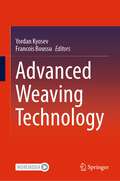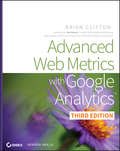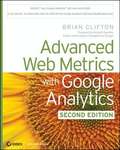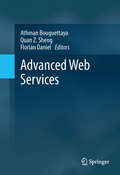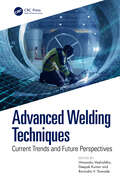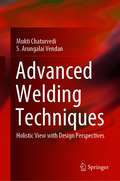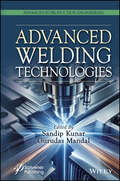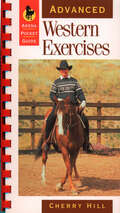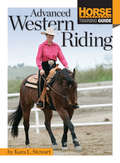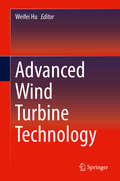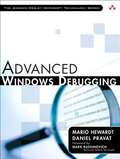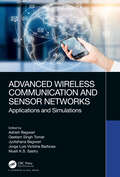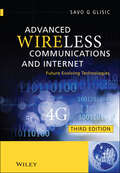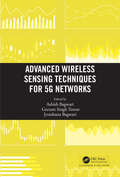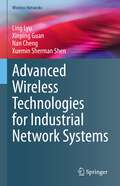- Table View
- List View
Advanced Virtual Environments and Education: Third International Workshop, WAVE 2021, Fortaleza, Brazil, March 21–24, 2021, Revised Selected Papers (Communications in Computer and Information Science #1425)
by Fernando Moreira Tiago T. Primo Alex S. Gomes César CollazosThis volume revised versions of the selected papers presented during the Third International Workshop on Advanced Virtual Environments and Education, WAVE 2021, held in Fortaleza, Brazil, in March 2021. The 7 full papers and 4 short papers presented were thoroughly reviewed and selected from the 27 submissions. The papers are organized in the following topical sections: learning scenarios and grouping methods; applications and scenarios, phigital, CS education and assessment; human computer interfaces for education, study cases for accessibility and wellbeing.
Advanced Visual Effects Compositing: Techniques for Working with Problematic Footage
by Lee LanierIn Advanced Visual Effects Compositing: Techniques for Working with Problematic Footage, learn to tackle difficult visual effect composites in layer-based and node-based compositing programs. In this book, industry veteran and compositing expert Lee Lanier offers tips, tricks, techniques, and workflows for difficult visual effects shots, including poorly shot green screen, moving shots with no visible motion tracking marks, shots requiring three-dimensional (3D) elements that lack 3D renders, poor-quality stock footage, and incorrectly lit shots. Lanier details the common problems of visual effects shots and offers practical solutions using examples from Adobe After Effects and Blackmagic Design Fusion. An accompanying eResource (www.routledge.com/9781138668348) features video image sequences, 3D renders, and other tutorial materials, allowing you to practice the discussed techniques. The visual effects challenges covered in this book include: Chroma keying Motion tracking Relighting in the composite Repairing plates Replicating damage Adding depth with 2.5D Working with stock footage
Advanced Visual Interfaces. Supporting Artificial Intelligence and Big Data Applications: AVI 2020 Workshops, AVI-BDA and ITAVIS, Ischia, Italy, June 9, 2020 and September 29, 2020, Revised Selected Papers (Lecture Notes in Computer Science #12585)
by Marco X. Bornschlegl Matthias L. Hemmje Marco Angelini Thoralf ReisThis book constitutes the thoroughly refereed post-workshop proceedings of the AVI 2020 Workshop on Road Mapping Infrastructures for Artificial Intelligence Supporting Advanced Visual Big Data Analysis, AVI-BDA 2020, held in Ischia, Italy, in June 2020, and the Second Italian Workshop on Visualization and Visual Analytics, held in Ischia, Italy, in September 2020. The 14 regular papers in this volume present topics such as big data collection, management and curation; big data analytics; big data interaction and perception; big data insight and effectuation; configuration and management of big data storage and compute infrastructures, services, and tools; advanced visual interaction in big data applications; user empowerment and meta design in big data applications; prediction and automation of big data analysis workflows; as well as data visualization; information visualization; visual analytics; infographics; and design.
Advanced Visual Interfaces. Supporting Big Data Applications: AVI 2016 Workshop, AVI-BDA 2016, Bari, Italy, June 7–10, 2016, Revised Selected Papers (Lecture Notes in Computer Science #10084)
by Marco X. Bornschlegl Felix C. Engel Raymond Bond Matthias L. HemmjeThis book constitutes the thoroughly refereed post-workshop proceedings of the AVI 2016 Workshop on Road Mapping Infrastructures for Advanced Visual Interfaces Supporting Big Data Applications in Virtual Research Environments, AVI-BDA 2016, held in Bari, Italy, in June 2016. The 10 revised full papers in this volume present the elaborated outcome of the initial position papers capturing the results oft the roadmapping discussions in the workshop at which comments of several external reviewers for these full publications were also integrated.
Advanced Voltage Quality Controller for New Power Distribution Systems
by Fei Jiang Qi Guo Chunming TuThis book focuses on the urgent demand for high-quality and efficient development of active distribution networks, which aims to address the bottleneck issues such as single functionality, low equipment utilization, and poor reliability encountered in the practical process of the commercialization of series-connected voltage-quality controllers. The book primarily conducts research on the expansion of functions and performance improvement of series-connected voltage-quality controllers, which summarizes some achievements and experiences of the authors in the new topology, new technology, new methods, and engineering application cases of advanced series-connected voltage-quality controllers. This book serves as a guidelines for scholars, students, engineers, and equipment manufacturers in the fields of power electronics technology and advanced power quality control technology.
Advanced Wastewater Treatment Technologies for the Removal of Pharmaceutically Active Compounds (Green Energy and Technology)
by Mohammadreza Kamali Tejraj M. Aminabhavi Lise Appels Raf Dewil Maria Elisabete V. Costa Shahid Ul IslamThis book reports on the treatment of waters and wastewaters with contaminants of emerging concern such as pharmaceutically active compounds. It shows how to prevent the contamination of the environment with such pollutants in the content of effluents. This book reviews various physico-chemical and biological methods that have been developed in order to deal with the polluted effluents. It also evaluates the already developed technologies regarding the sustainability criteria. The chapters discuss technical aspects and put the spotlight on the sustainability aspects of the water and wastewater treatment technologies.
Advanced Water Technologies: Concepts and Applications
by P.K. TewariThe book explores basic concepts and advanced topics in the field of water technologies. It deals extensively with advances in materials, material selection, preparation, characterization and application. The relevance of water technologies in industries is considered, and a section is dedicated to describing and analyzing the technologies required for water reuse and advanced purification, including desalination. Nuclear desalination, low-carbon desalination and water purification technologies to address the adverse impacts of climate change are examined from both the adaptation and mitigation points of view. Aimed at senior undergraduate/graduate students in chemical, civil and environmental engineering, along with wastewater and desalination researchers, this book: Details advanced water treatments for varied processes. Describes membrane and desalination techniques for water reuse and advanced purification. Elaborates water technologies at both the front and back ends of the process. Discusses modern technologies for effluent treatment and water recycling. Explores the role of information technology in the water sector.
Advanced Weaving Technology
by Yordan Kyosev Francois BoussuThis book sets the fundamentals of modern weaving at a new level. It contains information for the design of woven structures with complex cross section and multiple layers for modern applications, in the way that leading product developers, professors and researchers are using them now. It starts with the classical weaving principles and patterning and extends these quickly to multilayer structures, produced with single and multiple weft insertion devices, woven structures with complex cross section or direct 3D shape. The engineering methods for design of the structures using modern software and modern algorithms are also explained. Finally, an overview of different application areas is given. The book is written by the world leading experts in their fields and is prepared as learning tool for people interested in modern weaving. Exercises and end-of-chapter summaries will help the reader to check his own knowledge.
Advanced Web Metrics with Google Analytics
by Brian CliftonGet the latest information about using the #1 web analytics tool from this fully updated guideGoogle Analytics is the free tool used by millions of web site owners to assess the effectiveness of their efforts. Its revised interface and new features will offer even more ways to increase the value of your web site, and this book will teach you how to use each one to best advantage. Featuring new content based on reader and client requests, the book helps you implement new methods and concepts, track social and mobile visitors, use the new multichannel funnel reporting features, understand which filters to use, and much more. Gets you up and running with all the new tools in the revamped Google Analytics, and includes content requested by readers and users especially for new GA usersCovers social media analytics features, advanced segmentation displays, multi-dashboard configurations, and using Top 20 reports Provides a detailed best-practices implementation guide covering advanced topics, such as how to set up GA to track dynamic web pages, banners, outgoing links, and contact formsIncludes case studies and demonstrates how to optimize pay-per-click accounts, integrate AdSense, work with new reports and reporting tools, use ad version testing, and moreMake your web site a more effective business tool with the detailed information and advice about Google Analytics in Advanced Web Metrics with Google Analytics, 3nd Edition.
Advanced Web Metrics with Google Analytics, 2nd Edition
by Brian CliftonPacked with insider tips and tricks, this how-to guide is fully revised to cover the latest version of Google Analytics and shows you how to implement proven Web analytics methods and concepts. This second edition of the bestselling Advanced Web Metrics with Google Analytics is the perfect book for marketers, vendors, consultants, and Webmasters who want to learn the installation, configuration, tracking techniques, and best practices of Google Analytics. Google Analytics is a free tool that measures Web site effectiveness and helps users better understand how web site performance; this book is a detailed usage guide written by one of the software's original creators Explains what filters keep data accurate, how to measure Flash usage and tag for e-mail marketing, and what visitor segmentation provides the most useful feedback Examines principles and practices of Web analytics, then shows how to use GA's reports and how to track dynamic Web pages, banners, outgoing links, and contact forms Discusses advanced setups for configuring goals and filters, how to integrate GA with third-party systems, and how to leverage the new API Advanced Web Metrics with Google Analytics, Second Edition is valuable for both novice and experienced users of Google Analytics.
Advanced Web Services (Advances In Database Systems Ser.)
by Quan Z. Sheng Athman Bouguettaya Florian DanielWeb services and Service-Oriented Computing (SOC) have become thriving areas of academic research, joint university/industry research projects, and novel IT products on the market. SOC is the computing paradigm that uses Web services as building blocks for the engineering of composite, distributed applications out of the reusable application logic encapsulated by Web services. Web services could be considered the best-known and most standardized technology in use today for distributed computing over the Internet. This book is the second installment of a two-book collection covering the state-of-the-art of both theoretical and practical aspects of Web services and SOC research and deployments. Advanced Web Services specifically focuses on advanced topics of Web services and SOC and covers topics including Web services transactions, security and trust, Web service management, real-world case studies, and novel perspectives and future directions. The editors present foundational topics in the first book of the collection, Web Services Foundations (Springer, 2013). Together, both books comprise approximately 1400 pages and are the result of an enormous community effort that involved more than 100 authors, comprising the world's leading experts in this field.
Advanced Wedding Photojournalism: Professional Techniques for Digital Photographers
by Tracy DorrAiming to produce more vibrant, emotional, and compelling images, this guide instructs how to instinctively capture the most important moments at a wedding. By emphasizing a deeper understanding of the client and the importance of practicing technical skills, this in-depth reference explores the roles of preparation and patience in capturing memorable photographs. Since being in the right place at the right time is imperative, instruction is also provided on how to evaluate body language and subtle clues during the event. In addition, this manual, designed specifically for the professional wedding photographer, demonstrates how postproduction, album design, and photographer#150;client communication can maximize sales and customer satisfaction.
Advanced Welding Methods and Equipment
by Ruifeng Li Taotao LiThis book helps graduate students master welding theory, advanced welding technology and welding practice. With the continuous development and deepening of welding technology and the rapid development of computer science, the content of "Advanced Welding Methods" has also been expanded. It is divided into seven chapters, including laser welding, electron beam welding, friction stir welding, narrow gap welding, laser-arc hybrid welding, underwater welding, and development of the traditional welding process. The compilation of this book combines theory and practice, focusing not only on teaching and training theoretical knowledge, but also on integrating cases and providing practical training. Advanced Welding Methods and Equipment is a highly theoretical and practical course, which is an important link to improve students' welding practice ability and innovation ability. It is of great help for students to learn and understand welding technology. This book is used as a textbook for graduate students of related majors, and also as a reference for welding technology developers and researchers of related colleges and universities.
Advanced Welding Techniques: Current Trends and Future Perspectives
by Deepak Kumar Himanshu Vashishtha Ravindra V TaiwadeTo meet weight, quality, and cost targets, it is essential to design, develop, and manufacture optimal, cost- effective welded structures that take into consideration material, process, and dimensioning procedures. For effective design, a weld designer must have a comprehensive grasp of welding basics, associated metallurgy, and fabrication and characterization processes. Advanced Welding Techniques highlights breakthroughs in advances in welding methods and provides readers with the ability to accurately identify the appropriate welding processes and optimal improvement methods for intended applications. It offers comprehensive guidance on welding design to ensure readers are equipped to provide solutions to any technical malfunctions they may encounter, including: Supplies essential stepwise knowledge on design for welding, starting with the fundamentals to the complex Covers role of filler metals and parameters on welding performance, emerging and advanced welding techniques, and advantages and limitations of various methods Discusses integration of additive manufacturing and welding Contains practical applications Considers challenges and future scope for further research as well as future challenges This book offers students, academics, researchers, scientists, engineers, and industry experts a comprehensive overview of the most recent breakthroughs in advanced welding methods and their applications to joining various metals and their alloys.
Advanced Welding Techniques: Holistic View with Design Perspectives
by Mukti Chaturvedi S. Arungalai VendanThis book provides an insight into the welding techniques with a cross-disciplinary treatment to address the shortcomings of contemporary learning of welding terminology. Various topics covered include introduction to welding processes, design requirements, prominence of design, case studies presenting structural defacements due to inappropriate design, comprehensive surveys on welding processes selected from various process categories, design calculations to be adopted for specific applications and sample calculations. This book is useful for researchers, engineers and professionals working on welding equipment and technologies.
Advanced Welding Technologies (Advances in Production Engineering)
by Sandip Kunar Gurudas MandalAdvanced Welding Technologies serves as a vital resource that transforms the perception of welding from a mere skill-based practice to a cutting-edge industrial method, offering comprehensive insights into its fundamental processes, research advancements, and diverse applications across technological and biomedical domains. Welding has traditionally been considered more of a skill-based proficiency than a technological industrial method. The reliance on highly trained human operators, along with the high cost and low reproducibility of many welding processes, has contributed to this perception. Extensive research has now been conducted on the fundamentals of welding processes, and while it remains a complex, multidisciplinary subject, the basic concepts are well understood. Advanced Welding Technologies is a comprehensive collection of the processes and applications of advanced welding technologies, giving a basic understanding of each process, research advancements, and their applications in various technological and biomedical domains for improving machining accuracy and quality. This volume will extend the possibilities of research in various areas of advanced welding technologies with basic and hybrid approaches, making it an easy reference for students and researchers working in this critical field. Readers will find the book: Covers technologies for successful improvement in advanced processes and the application of advanced welding technologies; Serves as a valuable reference to students and researchers involved in working with advanced welding technologies; Discusses successful fabrication of multipurpose advanced welding technologies, sustainability of advanced welding technologies, materials and processes, applications of machine learning in advanced welding technologies, and future scopes and challenges of advanced welding technologies. Audience Engineers, welders, researchers, academics, and students involved in advanced welding technologies, manufacturing, and materials science.
Advanced Western Exercises
by Cherry HillStrengthen your Western riding skills as you progress through a series of proven and effective exercises. Perfect for quick reference in the ring, this guide includes illustrated directions, an arena guide, and plenty of patterns to master. Focusing on essential riding fundamentals like lateral work, master collection, lead changes, and transitions, Cherry Hill offers plenty of encouraging expert advice for riders seeking to improve their horsemanship. Enjoy the rewarding satisfaction that comes with taking your riding to a new and exciting level.
Advanced Western Riding
by Kara L StewartNewly updated and extended, Advanced Western Riding joins the experience and enthusiasm of equestrienne Kara L. Stewart with the wisdom of Horse Illustrated to bring this definitive guide to advanced western riders. The book goes beyond the fundamentals to teach readers how to refine their riding skills--from the right mental attitude to the proper seat and hands to advanced schooling techniques and competitions. Complete with step-by-step instructions, countless tips, full-color photos, and an easy-to-use glossary, this guide takes the guesswork out of advanced western riding.
Advanced Wind Turbine Technology
by Weifei HuPresents the latest developments in reliability-based design optimization, CFD of wind turbines, structural dynamics for wind turbine blades, off-shore floating wind turbines, advanced wind turbine control, and wind power and ramp forecasting for grid integration.<p> Includes techniques for wind turbine gearboxes and bearings, evaluation of lightning strike damage, health condition monitoring and reparation techniques.<p> Illustrates theories and operational considerations using graphics, tables, computational algorithms, simulation models, and experimental instrumentation.<p> Examines unique, innovative technologies for wind energy.<p> This book introduces the current challenges in modern wind turbine analysis, design and development, and provides a comprehensive examination of state-of-the-art technologies from both academia and industry. The twelve information-rich chapters cover a wide range of topics including reliability-based design, computational fluid dynamics, gearbox and bearing analyses, lightning analysis, structural dynamics, health condition monitoring, advanced techniques for field repair, offshore floating wind turbines, advanced turbine control and grid integration, and other emerging technologies. Each chapter begins with the current status of technology in a lucid, is easy-to-follow treatment, then elaborates on the corresponding advanced technology using detailed methodologies, graphs, mathematical models, computational simulations, and experimental instrumentation. Relevant to a broad audience from students and faculty to researchers, manufacturers, and wind energy engineers and designers, the book is ideal for both educational and research needs.<p> Presents the latest developments in reliability-based design optimization, CFD of wind turbines, structural dynamics for wind turbine blades, off-shore floating wind turbines, advanced wind turbine control, and wind power and ramp forecasting for grid integration;<p> Includes techniques for wind turbine gearboxes and bearings, evaluation of lightning strike damage, health condition monitoring and reparation techniques;<p> Illustrates theories and operational considerations using graphics, tables, computational algorithms, simulation models, and experimental instrumentation;<p> Examines unique, innovative technologies for wind energy.
Advanced Windows Debugging, 1st Edition
by Mario-Hewardt Daniel PravatThe First In-Depth, Real-World, Insider’s Guide to Powerful Windows Debugging <P><P>For Windows developers, few tasks are more challenging than debugging–-or more crucial. Reliable and realistic information about Windows debugging has always been scarce. Now, with over 15 years of experience two of Microsoft’s system-level developers present a thorough and practical guide to Windows debugging ever written. <P><P>Mario Hewardt and Daniel Pravat cover debugging throughout the entire application lifecycle and show how to make the most of the tools currently available–-including Microsoft’s powerful native debuggers and third-party solutions. <P><P>To help you find real solutions fast, this book is organized around real-world debugging scenarios. Hewardt and Pravat use detailed code examples to illuminate the complex debugging challenges professional developers actually face. From core Windows operating system concepts to security, Windows® Vista™ and 64-bit debugging, they address emerging topics head-on–and nothing is ever oversimplified or glossed over! <P><P>This book enables you to <ul> <li>Master today’s most powerful Windows debugging tools, including NTSD, CDB, WinDbg, KD, and ADPlus</li> <li>Debug code that wasn’t designed or written for easy debugging Understand debuggers “under the hood,” and manage symbols and sources efficiently</li> <li>Debug complex memory corruptions related to stacks and heaps</li> <li>Resolve complex security problems</li> <li>Debug across processes: identity tracking, RPC debugger extensions, and tracking IPCs with Ethereal</li> <li>Find and fix resource leaks, such as memory and handle leaks.</li> <li>Debug common thread synchronization problems</li> <li>Learn when and how to write custom debugger extensions</li> <li>Perform “postmortem debugging” using crash dumps and Windows Error Reporting</li> <li>Automate debugging with DebugDiag and the Analyze Debugger command</li> </ul> <P><P>Whether you’re a system-level or application developer, Advanced Windows Debugging delivers the deep understanding of debugging that could save you weeks on your very next project.
Advanced Wireless Communication and Sensor Networks: Applications and Simulations
by Ashish Bagwari Geetam Singh Tomar Jyotshana Bagwari Victória Barbosa, Jorge Luis Sastry, Musti K.S.This book covers wireless communication, security issues, advanced wireless sensor networks (WSNs), routing protocols of WSNs with cross-layer solutions, emerging trends in the advanced WSNs, power management, distributed sensing and data gathering techniques for WSNs, WSNs security, applications, research of advanced WSNs with simulation results, and simulation tools for WSNs. Features: Covers technologies supporting advanced wireless communication systems, sensor networks, and the conceptual development of the subject. Discusses advanced data gathering and sharing/ distributed sensing techniques with its business applicability. Includes numerous worked-out mathematical equations and formulas, as well as essential principles including figures, illustrations, algorithms, and flow charts. Provides pervasive background knowledge including both wireless communications and WSNs. Covers wireless networks as well as sensor network models in detail. This book is aimed at graduate students, researchers, and academics working in the field of computer science, wireless communication technology, and advanced WSNs.
Advanced Wireless Communications and Internet
by Savo G. GlisicThe new edition of Advanced Wireless Communications: 4G Cognitive and Cooperative Broadband Technology, 2nd Edition, including the latest developmentsIn the evolution of wireless communications, the dominant challenges are in the areas of networking and their integration with the Future Internet. Even the classical concept of cellular networks is changing and new technologies are evolving to replace it. To reflect these new trends,Advanced Wireless Communications & INTERNET builds upon the previous volumes, enhancing the existing chapters, and including a number of new topics. Systematically guiding readers from the fundamentals through to advanced areas, each chapter begins with an introductory explanation of the basic problems and solutions followed with an analytical treatment in greater detail.The most important aspects of new emerging technologies in wireless communications are comprehensively covered including: next generation Internet; cloud computing and network virtualization; economics of utility computing and wireless grids and clouds. This gives readers an essential understanding of the overall environment in which future wireless networks will be operating. Furthermore, a number of methodologies for maintaining the network connectivity, by using tools ranging from genetic algorithms to stochastic geometry and random graphs theory, and a discussion on percolation and connectivity, are also offered. The book includes a chapter on network formation games, covering the general models, knowledge based network formation games, and coalition games in wireless ad hoc networks.Illustrates points throughout using real-life case studies drawn from the author's extensive international experience in the field of telecommunicationsFully updated to include the latest developments, key topics covered include: Advanced routing and network coding; Network stability control; Relay-assisted Wireless Networks; Multicommodity flow optimization problems, flow optimization in heterogeneous networks, and dynamic resource allocation in computing cloudsMethodically guides readers through each topic from basic to advanced areasFocuses on system elements that provide adaptability and re-configurability, and discusses how these features can improve wireless communications system performance
Advanced Wireless Networks: Technology and Business Models
by Savo G. GlisicThe third edition of this popular reference covers enabling technologies for building up 5G wireless networks. Due to extensive research and complexity of the incoming solutions for the next generation of wireless networks it is anticipated that the industry will select a subset of these results and leave some advanced technologies to be implemented later,. This new edition presents a carefully chosen combination of the candidate network architectures and the required tools for their analysis. Due to the complexity of the technology, the discussion on 5G will be extensive and it will be difficult to reach consensus on the new global standard. The discussion will have to include the vendors, operators, regulators as well as the research and academic community in the field. Having a comprehensive book will help many participants to join actively the discussion and make meaningful contribution to shaping the new standard.
Advanced Wireless Sensing Techniques for 5G Networks
by Ashish Bagwari, Geetam Singh Tomar and Jyotshana BagwariThis book written for students of electronics and communication, students of computer science and communications engineers addresses topics such as Introduction of CRN, Advanced spectrum sensing techniques, Cooperative sensing techniques, Distributed sensing techniques, Issues in advanced sensing techniques, and Applications of 5G Networks. It provides new algorithms, explores recent results, and evaluates the performance of technologies in use in this area. It also provides new research topics and sensing techniques related to 5G networks for researchers.
Advanced Wireless Technologies for Industrial Network Systems (Wireless Networks)
by Xuemin Sherman Shen Nan Cheng Xinping Guan Ling LyuThis book provides a comprehensive overview of wireless technologies for industrial network systems. The authors first describe the concept of industrial network systems and their application to industrial automation. They then go on to cover the role of sensing and control in industrial network systems, and the challenge of sensing and control in the industrial wireless environment. Then, the existing techniques for resource efficiency information transmission are introduced and studied. Afterward, the authors introduce sensing and control-oriented transmission for industrial network systems, which take advantage of spatial diversity gain to overcome the interference and fading, which in turn improves the transmission reliability without expending extra spectrum resources and enlarging the transmission delay. Subsequently, edge assisted efficient transmission schemes are introduced, which integrate the capacities of communication, computing, and control to relieve the contradiction of resource limitation and massive data. Finally, the authors discuss open research issues and future works about information transmission in industrial network systems.
